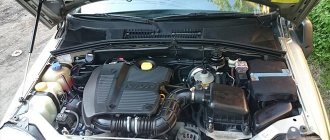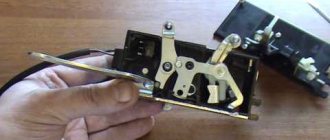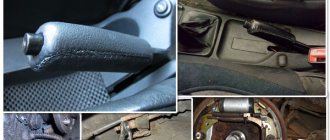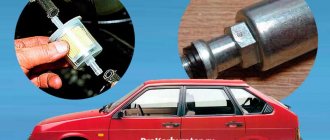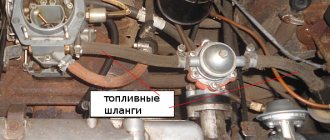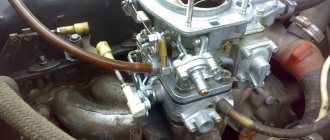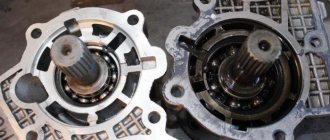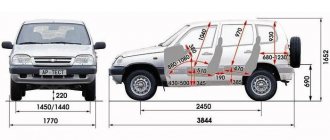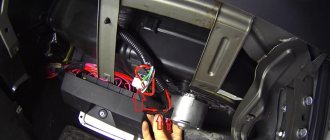Why does the Niva stall at idle (main reasons)
The Niva stalled immediately after starting, why?
Almost always, if a Niva car does not idle and stalls, the reason for this is contamination of parts, for example:
- The throttle valve, injector or carburetor is clogged.
- The idle relay has failed.
- The idle jets are dirty.
- The fuel pump is dirty.
- The engine ventilation system is clogged.
Problem solving
Therefore, you need to find the reason why the engine is not working correctly and fix it as quickly as possible. In order to understand what exactly has gone wrong, you need to start the engine at idle and listen to how it works; if regular popping sounds are heard from the exhaust system, this indicates that there are problems with the operation of one of the cylinders. This may be due to several reasons:
- No spark to spark plugs
- The injector may have failed
- Low compression in one of the cylinders, or there is a strong air leak into it
If the popping does not appear evenly, you can try replacing all existing spark plugs, even if they seem normal. If popping noises occur regularly, you should turn off the engine and open the hood, and check the condition of all existing ignition wires; they should not have any damage or oxidation of the tips.
To check the condition of the spark plugs, you need to remove the wire ends and unscrew the spark plugs with a special wrench. Check what condition they are in, if they look good, then put them in place, the main thing is that they are absolutely dry, if there are any drips, you can throw them away, also check what kind of gap they have, it should be from zero eight to zero nine millimeters.
If the engine does not operate smoothly at idle, you need to check the spark at the spark plugs. You can do this in the following way
- We take the spark plug, fix it on the engine so that the thread is on the body
- We connect the wire from the first cylinder to the spark plug, start the engine, if the interruption does not get worse, replace the spark plug with a new part. If after replacement there is an increase in interruptions, then it is necessary to check all the cylinders sequentially to understand which spark plug is faulty.
If, after following all the above recommendations, the problem remains, then you should contact a specialized car service center, where they will measure the engine compression. If the compression readings are more than one MPa, this is considered normal; if the reading is more than zero one MPa in one of the cylinders, then the engine needs to be repaired.
If during diagnostics a malfunction of the third cylinder is detected, you need to remove the hose that connects the engine and the vacuum brake booster, and then plug the hole in the hose, then start the engine; if the problem goes away, then you need to diagnose and most likely replace the vacuum brake booster. If the interruptions continue, you should try dousing the outer hose with a liquid like WD-40. Since there may be damage to the hose, if the problem is a rupture, then replacing the hose will help solve the problem.
Symptoms and causes of IAC malfunction
Signs of a malfunctioning idle speed sensor appear as follows:
- during a cold start, the crankshaft speed does not increase, which is why the engine runs unstable and tends to stall;
- there is a drop in the number of idle revolutions after a significant increase in the load on the generator - turning on headlights, electric heaters, and so on;
- the engine periodically stalls when any gear of the manual transmission is switched off (the symptom manifests itself while driving);
- The speed “floats” - it spontaneously increases and decreases.
If the car shows signs of IAC malfunction in the form of floating engine speed at idle, advanced diagnostics may be needed. A spontaneous change in the crankshaft rotation speed occurs for many reasons - failure of a sensor, air leaks, gas distribution malfunctions, and so on. It is better to start troubleshooting by checking the regulator.
IAC failure occurs for three main reasons:
- Open or poor contact in the power supply circuit. Simply put, there are problems with the wiring.
- Breakdown of the stepper motor due to natural wear and tear. In this case, only replacing the idle speed sensor will help.
- Contamination of the rod and cone with oil deposits.
There is a fourth reason - problems with the electronic control unit. The problem is quite rare and is accompanied by additional symptoms - increased gas mileage, unstable operation in all modes, difficult starting, and the like.
Oil deposits reach the rod thanks to secondary gases sent by the crankcase ventilation system for re-combustion. The more worn out the engine, the more deposits accumulate on the working cone. As a result, moving the rod becomes difficult; in advanced cases, the mechanism simply jams.
Preventing fuel pump breakdowns
The best prevention for long-term operation of the fuel pump is its careful and proper operation, as well as compliance with the following rules:
- All scheduled vehicle repairs must be accompanied by the replacement of all fuel filters.
- It is necessary to monitor and ensure the cleanliness of the fuel tank and filters, as well as monitor the quality of the fuel being refilled (the absence of water, sand and other impurities in it).
- Eliminate the possibility of water getting into the fuel tank.
- Protect the fuel pump housing from mechanical stress that causes dents and cracks that contribute to the development of corrosion processes.
Source of the article: https://voditelauto.ru/benzonasos_proverka_neispavnosti_remont/
Procedure for removing the device.
Idle speed sensor VAZ 2112
That’s probably all the differences, on the box it says that it is installed on cars of the VAZ “Niva”, “Chevy-Niva”, “Nadezhda” family of injection group, with a displacement of cm. I wanted to install the old one, but then I thought, if it’s not dirt, then remove the throttle again, well, screw it, put in a new IAC.
Let's put everything back together in reverse order.
Don't forget about the gasket. After assembly, we check whether everything has been assembled correctly, check the tightness of the clamps on the pipes, and try to start the car. Removing the damper is easy; just unscrew a few nuts.
Then disconnect the connector with wires from the IAC. Using a Phillips screwdriver, unscrew the screws that secure the regulator to the throttle valve.
This component controls the amount of air mixture that enters the cylinders. The main task of this part is to make this quantity optimal for high-quality ignition.
The Chevrolet Niva throttle valve is regulated by a special sensor, which, if necessary, closes it, forming a vacuum in the intake system, or opens it, allowing the air mixture to pass through.
If the TPS is faulty, then malfunctions occur during idling. In this case, you need to remove the element and carry out diagnostics. First you need to disconnect the wire block to de-energize sensor 2.
Checking the idle speed sensor To do this, the engine warms up to operating temperature. Then just check the sensor using a multimeter.
If it malfunctions, you must replace it with a new one. Throttle position sensor This component is responsible for the amount of air mixture entering the engine combustion chamber.
If the sensor is not configured correctly, the fuel supersaturated with air will detonate more strongly, spinning the engine faster and increasing speed. The sensor can also be checked using a multimeter.
Torpedo Priora 2 on VAZ 2110: On-site installation, wiring
Hello everyone who is interested in how the installation of the Priora 2 torpedo on the VAZ 2110 is going
There will be a lot of letters, since the entry is aimed at those who decide or have already decided to install a torpedo from Priora or Priora 2 on the tenth family
Meanwhile in the garage...
I turn on the stove and move on
I’m taking off the torpedo after the preliminary fitting, now it’s time for me to put it on and take it off, how to put on a shirt, I’ve lost count of how many times I’ve done this.
Next in line is laying the under-panel native tenth wiring. I remind you that I am leaving the tenth wiring, due to the inexpediency of switching to the wiring of Priora 2. On the Priora, the differences are: 1) From the fuse block to the center, the wiring runs above the steering column, at 2110 below it. Without extending a single centimeter of the wiring, it was easily possible lay it over the steering column, everything is real. 2) The wiring is held in place by its original clamps, which in turn are attached to the dashboard through iron brackets. I make my own:
Drilling holes
I install the same clamps on which the tenth sub-panel wiring was attached
As a result we get
I repeat that nothing was extended, except for the wiring to the backlight button and the glove compartment lighting itself + there are Prior connectors.
I untangled and separated the wires of the rear PTF buttons and the heated rear window (now they are not neighbors)
Preparing the installation site
For those who still doubt that the Priora torpedo may not fit the seats for the tenth family, I declare! fits perfectly!
If there are fewer fastening points, the load on the remaining fastenings increases accordingly. I welded the plates to the upper brackets (this is a rough version, maybe I’ll weld them and paint them), I’ll strengthen the lower ones later And then a surprise awaited me...
The bracket cracked and I didn’t notice it when I was welding the plate, or maybe the crack appeared after... in general, for welding
Central frame
I’ll say right away that you don’t need to buy a Priorovskaya one
No comments. The only thing that surprised me was the factory hole; the designers of AvtoVAZ foresaw that someday in the future they would invent the Priora and this hole would do its job.
The wiring is packed, everything is convenient, in order
I made it so that the entire torpedo could be removed with the under-panel wiring; a dozen additional connectors were added, most of which went to the alarm system (like a spider’s web connected the torpedo to the wiring and did not let go)
There are cracks, no matter how you look at them
Priorovodov, please respond, how is your situation with the cracks around the edges?
Some of the ground wires moved to the upper part, in my case to the steering column
That's all! The torpedo is installed, the wiring is laid out, the connectors are removed for further alteration, and you still have to remove it at least twice, but there are no problems, it has been done in such a way that all difficulties are reduced to a minimum.
To date
About R16
A small digression. A little more and the shesnari will delight the new owner, and I will move on - Be a hen!
WHAT'S NEXT?
In the following posts I will tell you how to install the tenth fuse block and make the emergency button work without a comfort block.
A thumbs up and repost are welcome as proof that the post is useful and it was not in vain that I sat and spent time sharing my experience with you.
Good luck!
How to restore the idle speed sensor?
The idle speed sensor for a VAZ 2114 costs about 350 rubles
In some cases, in order to restore this part, it is enough to simply clean it thoroughly. Cleaning the sensor itself is a very easy process, and for repairs it is enough to have only WD-40.
So, how to restore the idle speed sensor on a VAZ 2112? At the first stage, the two nuts securing the throttle assembly are unscrewed. The latter, as in the case of replacement, is moved 10 millimeters to the side. Next, the wire block is disconnected from the sensor. WD-40 is applied to a cotton swab, and all channels are thoroughly cleaned with it. Next, use a Phillips screwdriver to unscrew the two bolts that secure the VAZ 2110 idle speed sensor. If there are no fasteners here, then you will have to remove the entire throttle assembly. Next, the mechanism itself is pulled out. If it is covered in oil and black dirt, then in addition to cleaning the throttle body, you will need to clean the entire throttle body.
Next, WD-40 is applied to a conical needle with a spring. Thus, after a few minutes the sensor mechanisms will be cleaned of dirt. Then the device is dried, and it can be safely installed in place. Before installation, check the distance from the needle to the body of the device (one should be 23 millimeters). Idle speed sensor VAZ 2110, 21214, the essence of the idle speed sensor and replacement. At this stage, the idle speed sensor of the VAZ 2115 can be considered successfully repaired. The machine can operate normally again.
So, we found out how the idle speed sensor of the VAZ 2114 (and other models) works. Idle speed sensor VAZ 2114, otherwise the sensor will need to be completely replaced. And how it can be replaced/restored.
Comparison of Lada 110 and Lada 2170 Priora
VAZ 2110 and Lada Priora. They are so different, but at the same time so similar. Heredity is very clear. In addition to many technical differences and the time spent on the assembly line, these 2 models also have differences in quality and controllability, at least that’s what AvtoVAZ thinks. This is exactly what we will try to find out. For clarity, we have the Lada 110 and its successor, the Lada Priora, standing side by side, which has a factory index of 2170. It is also sold under this name in other markets. So, let's go.
Problems and solutions
There are a lot of reasons for unstable idle, and they apply to both carburetor and injection engines and even diesel engines, both to the old type design and to the new E-gas pedal, which AvtoVAZ is so proud of. Let's start with the problems that occur in carburetor-type engines:
- The fuel-air mixture has become lean. To fix the problem, you just need to make an adjustment to the level of eight hundred revolutions.
- Unstable running can also occur due to wear on the carburetor valve. In this case, the engine operates exclusively with the choke mode extended. To fix the problem, you need to replace the defective part with a new one.
- It also happens that the system channels become dirty. Then the fuel does not receive the required portion of air and leads to failure. Here you just need to clean the channels.
In the injection type of engine, there are no fewer reasons for failure.
- The first thing you can check is air leaks. Be sure to check the connection between the intake manifold and the cylinders to see if the gaskets are worn out. There are rubber plugs on the same manifold; if they are cracked, it is better to replace them. You can check all this by buying carburetor cleaner or any other flammable item in the store, start the car and spray all the joints, if there is a leak, the car will start to twitch, look in that place.
- They can cause gaps in speed and malfunctions in the IAC sensor (idle air control), it is often enough to remove it and clean it or inspect it for damage and replace it if necessary.
- It would not be amiss to check the throttle assembly, since it is not the strong point of the fourteenth model. It is possible that the throttle valve is simply clogged, which causes failures in the entire system. Cleaning it is not at all difficult; this work can be done independently.
- Wear or contamination of spark plugs also affects idle speed, as well as the entire operation of the engine. This is perhaps the most quickly solvable problem that can be eliminated by replacing old spark plugs with new ones in five minutes.
But problems with electronic equipment, in particular the famous E-gas, are much more complicated. Here it is observed:
- regulator failure (IAC);
- DMRV sensor failure;
- failure of the EGR valve (adsorber);
- damage to wires.
The regulator is checked using a multimeter. If the device produces unacceptable values, above 80 Ohms, then you need to replace the regulator with a new one, since repairing it will be problematic.
If the regulator is normal, then you need to check the mass air flow sensor. The check is as follows: the connector is disconnected and the motor is turned on.
If the speed dynamics, at the initial one and a half thousand revolutions, increases, there is no doubt that the breakdown lies in the sensor. As practice shows, 80% of VAZ-2114 malfunctions lie in this part.
Unstable to long-term operation and EGR, which regulates exhaust gas emissions. When it fails, operation can be normalized by cleaning the valve.
And the last thing that should be checked is the condition of the air filters, which on the fourteenth get clogged quite often, and the ignition system itself.
Checking the fuel pump of a carburetor car (mechanical)
Mechanical fuel pump - diagram
To check the operation of the fuel pump, you should:
- Remove the fuel hose from the carburetor inlet fitting.
- Immerse the hose in a specially prepared transparent bottle. By actively using the pumping lever manually, we notice how strong and dense the fuel is supplied. Air impurities should not be visually noticeable.
Delayed jet output is not a sign of a breakdown, especially if the car has been parked for a long time. As a rule, diaphragms eight and nine are the main cause of malfunction.
Be that as it may, you need to inspect both the strainer and the inlet/outlet valve.
Even if the gaskets are replaced, fuel may leak. In this case, the problem lies in the tightness of the fuel pump housing due to deformation during repairs.
The engine stalls immediately, but then starts
Idle speed regulator.
Here the reason may be in the firmware of the electronic engine control unit. The reason for this may be improperly performed tuning of the power unit. In this case, the engine will operate stably only at high speeds. If they drop below 1,000 rpm, the engine will simply stall. This malfunction can be eliminated by flashing the unit to the factory version of the program.
You should also pay attention to all kinds of sensors in car systems. These are, for example, the idle speed control, the throttle position sensor and others. They need to be checked at stands.
How to clean
In order to clean the IAC, it must be removed from its original location and disconnected from the connector.
You must first try to wedge the regulator with neutral silicone grease. It's okay if it gets inside the regulator. If the lubricant does not help, proceed to cleaning sequentially using alcohol, solvents, carburetor cleaners, and finally, if all else fails, the most aggressive WD wheel.
Cleaning is carried out by partially soaking the rod-working hole area for 10-15 minutes, after which you can blow through this area with a compressor.
In some cases, the cause of a malfunction of the idle air control system is a clogged bypass channel. It needs to be cleaned first. Cleaning the canal can be done using any suitable means using soft brushes made from natural fibers.
Signs of IAC malfunction
The main symptoms of a malfunctioning idle air regulator are:
- “swimming” of engine speed at idle;
- increased or decreased engine speed;
- spontaneous engine stop when switching the gearbox to neutral mode;
- at the time of cold start, the engine runs at high speeds, as it warms up it drops, the absence of this mode is also a sign of a malfunction of the regulator;
- reducing the engine speed when turning on an additional load (stove, headlights, brushes and other powerful consumers).
How to diagnose a faulty idle air control valve and adjust it
In a car, the idle speed sensor is responsible for stabilizing engine speed at idle.
You may wonder why this device is important, whether you can do without it, how to identify the problem, and what to do if it breaks down. The fact is that a malfunction of the regulator affects the operation of the engine as a whole.
In order to understand why it is necessary to constantly monitor its correct adjustment, let's look at the features of the motor.
Replacing the idle air control
For stable operation of the engine, a strictly dosed combination of fuel and air is necessary, otherwise “burning” will not occur, and if it does, it will be incorrect.
So, the idle air regulator is responsible for supplying air at idle, bypassing the throttle valve, which begins to open only when the gas pedal is pressed.
Essentially, this stepper motor, equipped with a conical needle with a spring, adjusts the amount of air up or down. It works in a single circuit with a mass air flow sensor and, depending on the receipt of the necessary information, regulates the process.
Oddly enough, it may seem, but for the engine the most difficult and “tiring” mode is operating at low speeds. This happens for a number of reasons.
- First, the fuel is cold and the engine as a whole needs to warm up to function properly.
- Secondly, the pressure difference between the exhaust and intake manifolds causes combustion products to be thrown back into the cylinders. As a result, there is a significant decrease in the “efficiency” of the engine. Parts wear out faster and more severely. In addition, the percentage of carbon dioxide in exhaust increases.
All this happens as a result of the fact that at this stage there is a slow supply of the air-fuel mixture into the exhaust system. As a result, it mixes less well, which reduces its effectiveness.
You can often hear the opinion that when creating cars, engineers make such developments and calculations so that the idle speed control functions throughout the entire “life” of the engine.
The idle air control may break down for various reasons, including: and from mechanical stress
The reality is that it fails quite often. This is usually caused by problems with the wiring. In order to avoid problems and ensure normal engine operation at idle, various devices are used, as an option: install an idle speed controller (mechanical). This can significantly reduce exhaust toxicity.
Let's look at what deviations in engine operation make you think. It should be taken into account that some of them are also characteristic of other problems, for example, poor quality of the fuel used, failure of the throttle sensor. But there are also specific features.
- The engine is unstable at idle. This is clearly audible: changes in speed become obvious. In addition, engine vibration may occur, which has an extremely negative effect on its operation. As a result, the time resource of its operation is reduced.
- When the gear is switched off, the engine stops completely. This problem is especially noticeable at traffic lights, and as a result it is dangerous.
- The speed is unstable (randomly decreases or increases). “Dancing” sounds appear.
- After starting, the unit “refuses” to operate at higher speeds (that is, you press the gas pedal, but there is no reaction).
- When some electrical appliances are turned on: heater, air conditioner, long-range headlights or fog lights, the engine speed decreases.
Such problems occur as a whole when the situation is neglected. Even if one of the above appears, measures must be taken.
Regardless of what caused the breakdown, there is no point in delaying diagnosis and replacement; this type of breakdown significantly affects the operation of the engine, which is not for nothing called the “iron heart” of the car. So, what could be the reason:
- The needle guides have been erased.
- The wire inside the sensor has broken.
Spark plug
Problems arise due to the lack of a spark, and may arise due to the appearance of soot and dirt, which prevents the formation of a spark. If there is this deposit or dirt on the contacts, then it is advisable to change the fuel to a higher quality one, and you should also check the condition of the oil supply system, since a malfunction of the sensor that regulates the oil supply leads to the spark plugs splashing. Also, the appearance of oil indicates that there are problems in the cylinders. Therefore, if you see the presence of all the above phenomena, then it is advisable to diagnose the engine in a car service center, and if the reasons for their occurrence are not eliminated in time, this can lead to an expensive replacement of pistons with jet thrusts.
If you systematically use low-quality fuel, a brown coating appears on the spark plugs, and simple cleaning will not help, so it is better to make a complete replacement.
How to identify a problem with the idle air control (IAC) on a Chevrolet Niva
The most common causes of failure of the idle air regulator (IAC) 21203 - 1148300 on the Chevrolet Niva -2123, VAZ 2131 (NIVA) and VAZ - 2120 "Nadezhda" modifications.
Symptoms of IAC malfunctions are in many ways similar to TPS (throttle position sensor) malfunctions, but in the second case, most often the “CHECK ENGINE” lamp clearly indicates a TPS malfunction.
Malfunctions in the operation of the idle speed controller (IAC) 21203 - 1148300 are difficult to identify, because the idle speed sensor on the Chevrolet Niva - 2123, VAZ 2131 (NIVA) and VAZ - 2120 "Nadezhda" of their modification is an actuator and is not covered by a general control system, and if there is a malfunction in its operation, the “Check-Engine” indicator light does not signal.
But some characteristic symptoms suggest that the idle speed sensor is faulty, for example:
— unstable idle speed;
— when setting the gearshift lever to the neutral position, the engine stops involuntarily;
— idle speed decreases noticeably when other devices (heater, headlights) are turned on;
— involuntary increase or decrease in speed, regardless of the engine operating mode;
— when a cold engine starts, difficulties arise in reaching higher speeds.
There are several ways to check the idle speed sensor on the Chevrolet Niva - 2123, VAZ 2131 (NIVA) and VAZ - 2120 "Nadezhda" modifications.
A few more words about over-revving
If servicing the above components does not lead to the restoration of idle speed, you should pay attention to another component, which is the electronic control unit, which drivers call among themselves “brains”. Problems in its operation in many cases lead to such failures. If this is the case, then the ECU is simply replaced with a new unit.
To prevent this from happening to your car, follow the deadlines and carry out proper maintenance of the car and its systems. Use high-quality operating fluids, then you will not have a question about why the engine speed on the Chevrolet Niva does not reset. We hope that if such a malfunction occurs, the article will help in resolving it.
Replacing the idle speed sensor on a Chevrolet Niva
Self-diagnosis Niva Chevrolet, replacing the idle speed sensor
The engine does not hold idle speed well or stalls. The injector
High, low, engine speeds fluctuate. Mass air flow sensor, DBP+DTV, Air leak. Troubles the engine 2h
The Chevrolet Niva has lost idle speed. The coolant temperature sensor is faulty.
Strange behavior of Niva. We diagnose the internal combustion engine.
The engine of a fuel-injected VAZ car stalls
The car stalls at idle. Video
idle speed disappears. stalls at traffic lights. in neutral. cause found
Stalls when cold. Injection engine. No singles
A frequent type of breakdown of a car, especially ours (VAZ cars), is when the car stalls at idle. It manifests itself like this: - we started the car, we accelerate, everything is fine, we just take the pedal off the gas, the speed starts to float, the engine detonates (jerks). That is, the engine speed fluctuates from 100 to 1000, although the tachometer needle should be at the 1000 revolution mark. After a while the car stalls. If we start it, then it all repeats. What to do? Let's figure it out......
The car stalls at idle
I will list the reasons why the car does not idle.
1) The first reason, and perhaps the most likely, is the idle speed sensor. It is this sensor that is designed to keep the car idling while starting the engine. It is very easy to check, if the car does not start, that is, the starter turns the engine, but the car does not start, then try to press the gas pedal a little, the car should start. But if you take your foot off the gas pedal, the revolutions will begin to “float”, then the car will stall. Such symptoms are typical for the idle speed sensor. We just change it, on our VAZ it changes in five minutes.
2) Perhaps the car’s throttle valve is simply clogged. The idle speed of the engine will fluctuate, and the car may also stall. Just need to clean the throttle body. You can read how to clean the throttle valve on FORD cars.
3) If cleaning the throttle valve does not help, then your throttle position sensor (TPS) may be broken. We change it only after we have cleaned the throttle valve itself. It is located next to the idle speed sensor and can also be changed in five minutes.
These are, in principle, all the reasons that affect the operation of a car engine at idle. If you have a VAZ car, then replace both sensors at once, the idle speed sensor and the throttle position sensor, but do this after cleaning the valve itself. The problem that the car stalls at idle should disappear.
Why do you need a properly set idle speed?
When it comes to a car, the concept of idling can be attributed to the operation of the engine when the gear is off or when the clutch pedal is depressed. In such cases, the engine runs without load, that is, there is no transmission of torque from the power plant to the drive wheels. For different engines, idle speed can range from 600 to 1000 rpm.
If their indicator is less than the recommended value, the engine will stop when the clutch pedal is pressed. An increase in their number, in addition to a significant increase in gasoline consumption, leads to accelerated wear of engine parts. Therefore, it is so important to maintain their number in the recommended range.
Idle speed adjustment is carried out by several components and assemblies installed on the vehicle. These include an injector, a fuel pump, and various sensors, which can be mechanical or electronic. This also includes the throttle valve, fuel pressure regulator and some other devices.
The number of revolutions is greatly influenced by the opening angle of the throttle valve, which regulates the amount of air entering the engine power system. The idle air valve also takes part in mixture formation, which is needed to provide air supply bypassing the throttle valve. In some cases, an increase in their number may be caused by an incorrectly adjusted gas pedal drive.
Location of fuse and relay blocks Niva 4x4
The main part of the fuses are located in the Niva's interior under the panel to the left of the steering column. Total 4 blocks:
1 — engine control system fuse box; 2 — windshield wiper relay; 3 — fuse blocks; 4 — relay block of the engine control system.
The fourth relay block is located above the gas pedal.
Adjusting the idle speed of a Chevrolet Niva
The idle air regulator is a special device that regulates the air supply. It is made in the form of a cone-shaped valve, which is driven by an electric motor. The ECU is activated, which determines the required channel opening level.
The Niva Chevrolet idle speed control is non-separable, therefore, if there are problems with its operation, it must be completely replaced. Dismantling is somewhat difficult, since to remove the regulator it is also necessary to disconnect the throttle assembly.
Procedure for removing the device.
To remove this device, you need to stock up on a small set of tools, consisting of a 13mm socket wrench, a screwdriver and pliers.
- Place the vehicle on a flat surface and secure it with the parking brake. If there is any doubt about the stability of the car, you need to install wheel chocks.
- After this, you need to disconnect the battery terminals.
- We unscrew the fastening nuts and studs that secure the receiver to the throttle valve. In this case, there is no need to disconnect the pipes of the cooling and crankcase ventilation system.
- Disconnect the terminals from the wires
- Using a Phillips screwdriver, unscrew the valves on the throttle valve
- When the device mount is unscrewed, you can remove it from its seat. Usually, you can get the O-ring along with it. But, in some cases, it may get stuck in the damper well.
- In this case, it is necessary to carefully dismantle it.
But sometimes the device may be working properly, but problems in operation are associated with its clogging. In this case, you can try cleaning it with carburetor cleaner. Typically, this method helps to revive a device that has no visible mechanical damage. But this measure does not guarantee a 100% result, but is only temporary, which allows you to get to the nearest service station or store with spare parts.
The idle speed of the Chevrolet Niva may be incorrectly adjusted if the sensor has increased travel between the valve and the supporting surface. When measured with a caliper, this distance should not exceed 23 millimeters.
Compliance with these parameters is necessary in order to ensure correct installation and not damage the throttle body.
Before installation, the seat must be cleaned. You can also lubricate the O-ring with engine oil to make it easier to put it in place.
Throttle sensor.
The Niva Chevrolet throttle sensor can also affect the smooth operation of the engine at idle. This component controls the amount of air mixture that enters the cylinders. The main task of this part is to make this quantity optimal for high-quality ignition.
Electricity supply
If the engine turns off while driving, but it is not difficult to start it, then the problem is most likely a faulty power supply. Problems can be caused by several reasons:
- The battery terminals have poor contact
- There is a breakdown along the entire length of the power wires
- There is a malfunction in the ignition coil system or generator
If the wires are damp, it is better to replace them along with the battery. If the terminals have poor contact, they need to be cleaned. If the generator does not work, this may be due to the fact that the timing belt has broken or there is a malfunction inside the generator itself. A problem with the generator on a Chevrolet Niva is easily determined using the indicator on the dashboard. In addition, if the energy supply is insufficient, the backlight of the car’s dashboard will be weak, and the sensor values will be incorrect.
